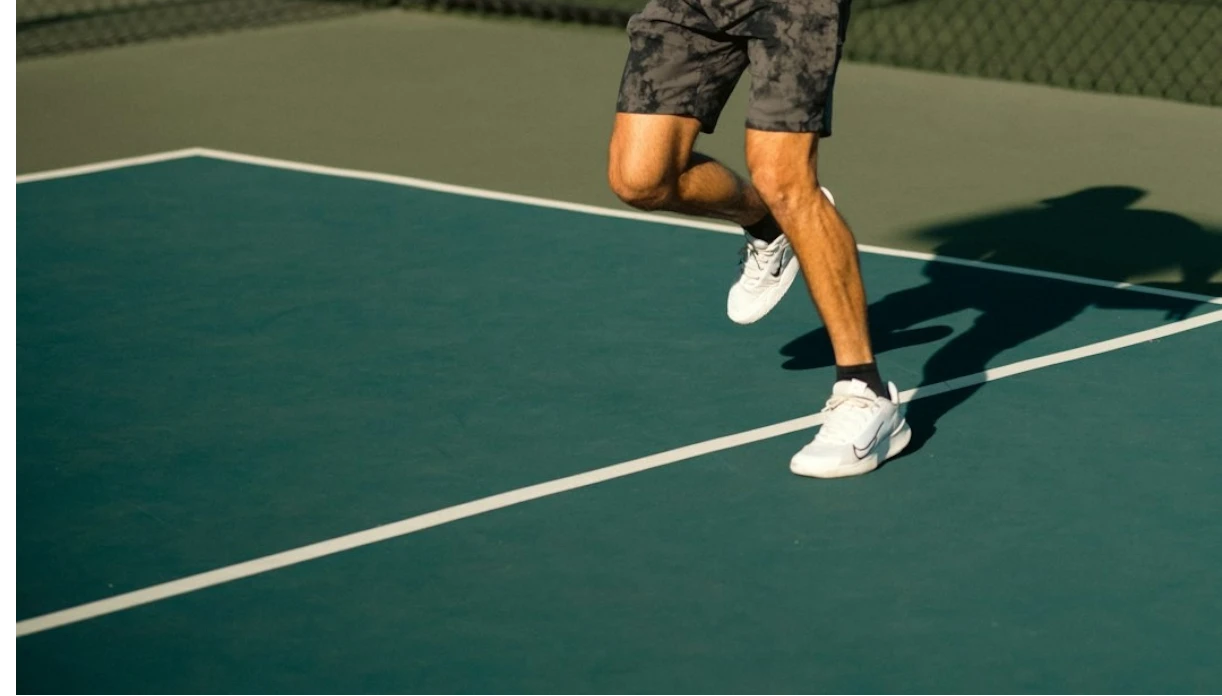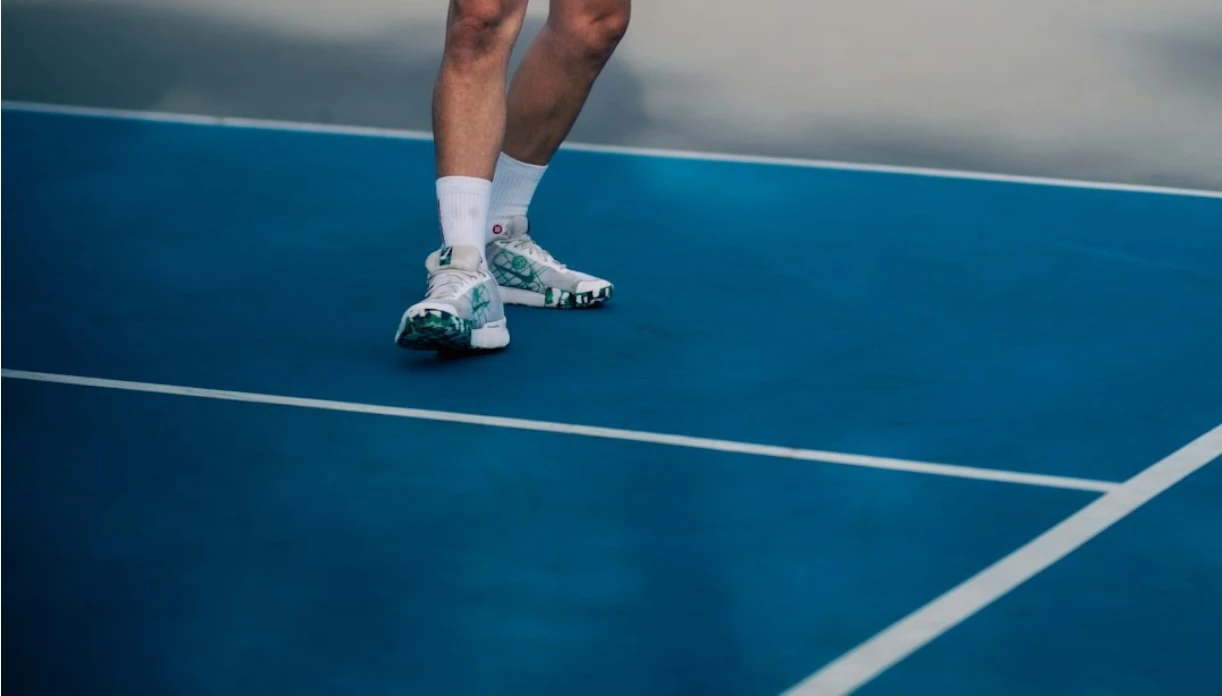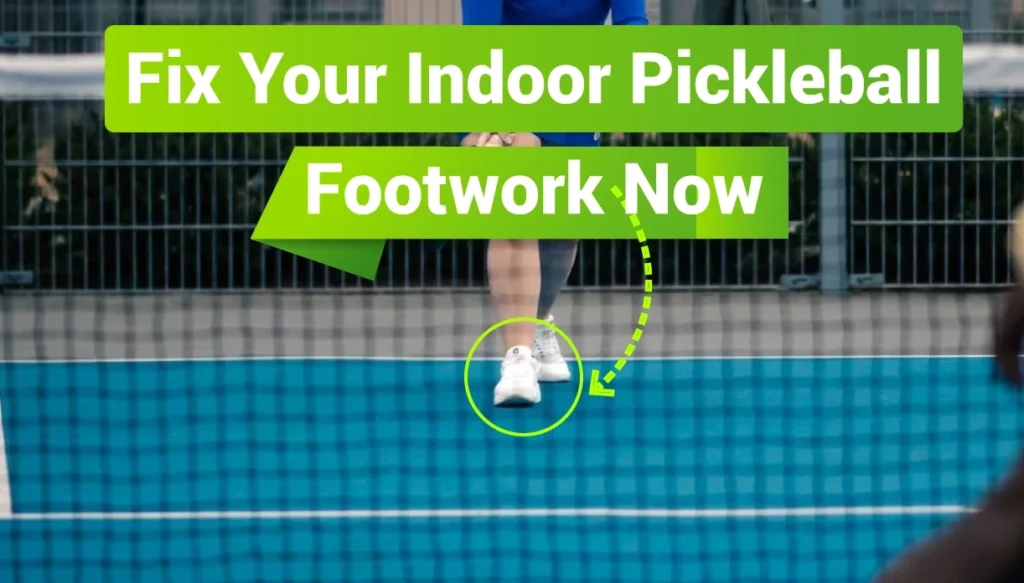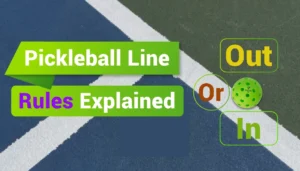To fix your indoor pickleball footwork, you need to stay light on your toes, use small, controlled steps, and always be ready to adjust quickly—it’s all about balance, positioning, and staying engaged every second on the court.
Footwork is the secret weapon in pickleball. You can have the sharpest dinks and the flashiest paddle, but if your feet aren’t in the right place at the right time, you’ll always feel just a step too slow.
Trust me—I’ve been there. When I first started playing indoor pickleball, I kept sliding when I should’ve been shuffling, and I got burned on fast shots I thought I could reach.
Indoor courts move quicker, the ball stays lower, and you’ve got to react fast with sharp, balanced steps. The good news? You can fix this. I’ll show you simple footwork adjustments that changed my game—and can change yours too—starting today.
Let’s get you moving smarter and winning more points!
Why Footwork Matters Even More Indoors

Indoor pickleball can be a totally different beast compared to outdoor play. The ball moves faster, and the surface is smoother, meaning your movements have to be quick and precise.
When you control your footwork, you control the court. Bad footwork? That leaves you struggling to reach shots, and feeling out of position all the time.
Quick story: The first time I played indoors, I kept sliding a little after each shot—it was a mess! I was late to everything because my feet just weren’t ready for the faster pace.
That’s when I realized footwork was the key to surviving indoors.
The Foundation: Perfecting Your Ready Position
Your ready position is like the foundation of a house—everything falls apart without it. And in indoor pickleball, where speed is everything, staying in a solid ready position will make sure you’re prepared for whatever comes your way.
Here’s what you do:
- Stand with your feet shoulder-width apart.
- Keep your knees slightly bent so you’re low and ready to move.
- Keep your weight on the balls of your feet, not your heels. This makes it easy to spring into action.
- Hold your paddle out in front of you at eye level—ready to go.
Pro Tip: Imagine you’re “dancing” on your feet, lightly bouncing before every shot. It keeps you quick and alert, ready to react.
The Split-Step: Your Secret Weapon Indoors
“What’s a split-step?” It’s something that tennis players use all the time, and it’s gold for pickleball too. The split-step lets you stop quickly and get into position for any shot your opponent throws at you.
Here’s how you do it:
- Right before your opponent hits the ball, take a small hop.
- Land with your feet slightly wider than shoulder-width apart.
- Keep your knees bent and be ready to move in any direction—sideways, forward, or backward.
This simple step stops your momentum and gives you balance. The wider your base, the quicker you can react.
Try This Drill: Set up some cones or markers around the court. Shuffle side-to-side using your split-step to react to a ball being thrown at random spots.
Trust me, after a few rounds of this, you’ll start to feel the difference in your reaction time!
Court Coverage: Lateral Movements for Dominating the Indoor Court
When it comes to covering the court indoors, your side-to-side movement is everything. Lateral (sideways) movement helps you reach those wide-angle shots that your opponent sends crosscourt. If your feet aren’t quick, you’ll be lunging awkwardly or even missing shots completely.
Here’s what you should focus on:
- Stay low and balanced. If you’re standing too upright, you’ll be slower to react.
- Use small shuffle steps to move across the court.
- Avoid crossing your feet over each other—this slows you down.
Drill Time!: Try the “Kitchen Shuffle”. Stand at the kitchen line and shuffle from one side of the court to the other.
Stay low and balanced. If you want to make it fun, challenge a buddy to see who can shuffle side-to-side faster without losing their form!
Mastering Forward and Backward Movement: The Key to Control
Indoor pickleball is fast. To keep up, you need to be moving forward and backward with purpose. Whether you’re rushing the net or retreating after a deep shot, controlling your steps is crucial.
- When moving forward: Take quick, short steps and always be ready to stop with a split-step.
- When moving backward: Use small controlled steps to avoid losing balance or backing up too far.
Drill Idea: Practice moving in and out by starting at the baseline and quickly advancing toward the net in three steps or fewer. Use a split-step when you reach the kitchen line to keep your balance.
Pro Tip: Once you’ve got your movement down, pair it with effective dinking to fully control the kitchen. Check out these pickleball dinking drills to sharpen your soft game and keep your opponents on their toes.
Fun Challenge: See how fast you can do it and try to beat your time each round!
Transitioning to the Kitchen Line: The Indoor Player’s Key to Winning

Here’s where the magic happens! Getting to the kitchen line quickly and safely is one of the best ways to dominate your opponent. But the transition can be tricky, especially in a fast-paced indoor game.
When you hit a good third shot (especially a drop), start advancing to the kitchen line. Key Tip: Don’t rush if your shot is weak. Only move forward when you’ve set yourself up with a good shot.
Drill: Practice hitting your third shot and moving to the kitchen line in just a few steps. The goal is to be at the net by the time your opponent hits the ball again. Work on doing this while keeping your balance and using your split-step when you arrive.
Defending Against Fast Shots Indoors: Fast Feet, Fast Reactions
Indoors, shots come at you FAST. That’s why having quick feet and fast reactions is essential for defending against hard-hitters. Whether it’s a volley exchange at the net or a fast drive from the baseline, staying low and on your toes will help you return the ball.
Here’s how:
- Keep your stance low and wide.
- Stay on the balls of your feet for quick reactions.
- Take small steps—no giant lunges!
Drill: Do rapid-fire volley drills with a partner or ball machine. Focus on quick, sharp movements without stepping too much. Count how many volleys you can return in a row—it’s a great way to improve your reflexes and footwork.
Conditioning for Indoor Footwork: Build Strength and Stamina
Strong legs = fast feet. If you want to improve your footwork, you need to work on leg strength and endurance.
Try These Exercises:
- Lunges: Great for building leg strength and balance.
- Agility Ladder Drills: These help with quick, precise foot movements, making you faster on the court.
Pro Tip: Add these exercises to your warm-up routine before a match. Not only will they improve your footwork, but they’ll also help prevent injuries.
Avoiding Common Footwork Mistakes Indoors

We all make mistakes, but the good news is you can avoid some of the most common footwork slip-ups. Here’s what to watch out for:
- Overstepping: Don’t take big steps! Keep them short and controlled.
- Being Flat-Footed: Stay light on your toes, not stuck on your heels.
- Backing Up Too Far: Don’t retreat too much. Stay in control of your positioning.
Advanced Indoor Footwork Techniques
For those who want to take their game to the next level, there are some more advanced footwork moves you can work on:
- Step-Step Return: Perfect for returning fast serves with control.
- Drop-Step: A great move when you need to get behind the ball for a defensive shot.
Pro Challenge: Set up a game-like scenario and practice defending against deep lobs. Use the drop-step to move back quickly, and then get right back into position.
Warm-Up and Stretching: Prepping Your Feet for Indoor Play
Just like any sport, pickleball requires a good warm-up. Take 5-10 minutes before a game to stretch and get your feet moving.
Dynamic Warm-Up Routine:
- Light jogging or high knees.
- Ankle rotations.
- Quick side shuffles to loosen up.
Make Footwork the Foundation of Your Indoor Game
Footwork is the backbone of your indoor pickleball game. With these drills and tips, you’ll not only improve your balance and reaction time, but you’ll also feel more confident and in control on the court. Practice these drills regularly, and watch your game transform!
Final Challenge: Grab a partner, try out some of these drills, and see how much your footwork improves over time. And don’t forget—post a video of your progress in your favorite pickleball group or tag me on social media so I can see your improvements!
FAQs on Improving Indoor Pickleball Footwork
Why is footwork more important in indoor pickleball?
Indoor courts are faster, and precise footwork helps you react quickly, maintain balance, and control the game.
What is the split-step, and why should I use it?
The split-step is a small hop you take just before your opponent hits the ball, allowing you to stop and move quickly in any direction.
How do I move quickly to the kitchen line after my third shot?
Use short, quick steps, and always split-step when you get close to maintain balance and be ready for the next shot.
Why are lateral movements so important indoors?
Indoors, fast side-to-side movements help you cover wide-angle shots and stay in control during quick rallies.
What should I focus on when defending against fast shots?
Stay low, keep your weight on the balls of your feet, and use small, controlled steps to react quickly.
How can I improve my footwork speed?
Practice agility drills like ladder drills and cone shuffles to build quickness and control.
What’s the best way to avoid common footwork mistakes?
Focus on staying low, keeping steps small and controlled, and maintaining a light bounce on your toes.
How can I stop backing up too far when defending deep shots?
Practice using the drop-step technique and always stay aware of your positioning relative to the baseline.
What warm-up exercises can I do to improve footwork?
Try dynamic warm-ups like high knees, light jogging, ankle rotations, and side shuffles to prepare your legs for quick movements.
Can better footwork help me beat hard hitters?
Absolutely! Quick footwork helps you stay balanced and prepared to counter fast shots, giving you an edge against aggressive players.



